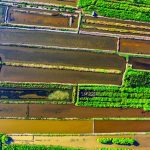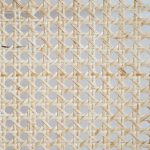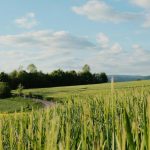You’ll find woven geotextiles made by tightly interlacing yarns, giving them high tensile strength and durability for heavy-duty reinforcement like road construction. Nonwoven geotextiles, made by bonding random fibers, offer better permeability and filtration, ideal for drainage and erosion control. Woven types handle heavy loads but cost more, while nonwoven ones are flexible, easier to install, and more affordable. Understanding these differences helps you pick the right geotextile for your project’s needs. Keep exploring to discover their full range of benefits and applications.
Table of Contents
Key Takeaways
- Woven geotextiles are made by interlacing yarns at right angles, while nonwoven geotextiles bond fibers randomly through mechanical, chemical, or thermal means.
- Woven geotextiles offer higher tensile strength and stability, making them ideal for reinforcement, whereas nonwoven types provide better flexibility and filtration.
- Nonwoven geotextiles have higher permeability for efficient water drainage, unlike woven types that have lower permeability suited for separation and load-bearing.
- Woven geotextiles are commonly used in heavy-duty applications like road construction, while nonwoven ones excel in drainage, erosion control, and soil separation.
- Woven geotextiles generally cost more but last longer, whereas nonwoven geotextiles are cheaper, easier to install, and require more frequent maintenance.
Definition and Manufacturing Processes
Although woven and nonwoven geotextiles serve similar purposes, they differ considerably in their definitions and manufacturing processes.
You’ll find woven geotextiles are made by interlacing two or more sets of yarns at right angles, creating a fabric with a grid-like structure. This method gives you strength and stability, ideal for reinforcement tasks.
Nonwoven geotextiles, on the other hand, are produced by bonding fibers together through mechanical, chemical, or thermal means, resulting in a felt-like fabric. This process makes them excellent at filtration and drainage because of their random fiber arrangement.
When you choose between them, keep in mind these fundamental differences in how they’re made, as it directly impacts their performance in various civil engineering and landscaping applications.
Material Composition and Structure
Understanding how woven and nonwoven geotextiles are made helps clarify why their material composition and structure vary considerably.
Woven geotextiles consist of continuous filaments or yarns tightly interlaced in a grid-like pattern, creating a strong, stable fabric. You’ll find they’re usually made from polypropylene or polyester fibers that give a consistent and durable structure.
Nonwoven geotextiles, on the other hand, are made by bonding or entangling short fibers randomly, either chemically, thermally, or mechanically. This process results in a fabric that’s more porous and flexible. Typically, nonwovens use polypropylene fibers as well but in a loose, felt-like form.
Knowing these differences helps you choose the right geotextile based on how its material composition and structure will perform in your project.
Mechanical Properties and Strength
When choosing between woven and nonwoven geotextiles, you’ll want to evaluate their tensile strength and how they hold up over time.
Woven types typically offer higher strength, while nonwoven options provide better flexibility and durability.
Understanding these differences helps you pick the right fabric for your project’s demands.
Tensile Strength Comparison
Because tensile strength directly affects a geotextile’s ability to withstand loads and stresses, you need to carefully compare woven and nonwoven options.
Woven geotextiles typically offer higher tensile strength due to their interlaced yarn structure, making them great for heavy-duty applications. Nonwoven geotextiles, made by bonding fibers randomly, usually have lower tensile strength but excel in other areas.
Here’s what you should consider:
- Woven geotextiles can handle greater tensile loads without breaking.
- Nonwoven geotextiles often stretch more before failure, providing some flexibility.
- The strength of woven types suits reinforcement and stabilization tasks.
- Nonwoven strength suffices for filtration and drainage where heavy loads are minimal.
Understanding these differences helps you pick the right geotextile for your project’s load requirements.
Durability and Flexibility
Tensile strength plays a big role in how geotextiles perform under stress, but durability and flexibility also shape their overall effectiveness.
When you choose woven geotextiles, you get high durability due to their tightly interlaced fibers, making them resistant to tearing and abrasion. However, they tend to be less flexible, which might limit their use in applications requiring contour adaptability.
On the other hand, nonwoven geotextiles offer greater flexibility, allowing you to conform easily to uneven surfaces. This flexibility comes with slightly lower durability, as their randomly arranged fibers can be more susceptible to mechanical damage.
Understanding these differences helps you pick the right geotextile based on whether your project demands toughness or adaptability.
Permeability and Filtration Capabilities
You’ll want to understand how woven and nonwoven geotextiles handle water flow and retain particles.
Each type offers different drainage performance that can impact your project’s efficiency.
Let’s compare their permeability and filtration capabilities to see which suits your needs best.
Water Flow Efficiency
When managing water flow in your project, understanding the permeability and filtration capabilities of woven and nonwoven geotextiles is crucial.
Woven geotextiles typically offer higher tensile strength but lower permeability, making them better for separation and reinforcement. Nonwoven geotextiles, with their random fiber arrangement, provide superior permeability and filtration, allowing water to flow more freely while filtering fine particles.
Consider these key points to evaluate water flow efficiency:
- Woven fabrics control flow rate with smaller pore sizes, reducing water passage speed.
- Nonwoven fabrics allow rapid drainage due to their high permeability.
- The choice depends on project needs—reinforcement versus drainage.
- Proper selection guarantees efficient water management and prevents structural issues.
Particle Retention Ability
Understanding how water flows through geotextiles naturally leads to examining their ability to retain particles while allowing water to pass.
When you choose woven geotextiles, you get a tightly woven structure that offers excellent filtration by trapping larger soil particles, preventing erosion while maintaining good permeability. However, its smaller pore size may reduce water flow compared to nonwoven types.
On the other hand, nonwoven geotextiles feature a random fiber network with higher porosity, letting water flow freely while filtering out finer particles effectively. This makes them ideal when you need better filtration without sacrificing permeability.
Drainage Performance Comparison
Drainage performance plays an essential role in choosing between woven and nonwoven geotextiles, especially regarding permeability and filtration capabilities.
You’ll want to reflect on these key differences:
- Permeability: Nonwoven geotextiles typically allow water to flow through more easily, making them excellent for drainage.
- Filtration: Woven geotextiles offer better control over particle retention but may have lower permeability.
- Clogging Resistance: Nonwovens resist clogging better due to their random fiber arrangement.
- Application Suitability: If you need high water flow with good filtration, nonwoven is preferable; for stability with moderate drainage, woven works well.
Typical Applications and Use Cases
Geotextiles play an essential role in many civil engineering and landscaping projects by improving soil stability and controlling erosion.
When you choose woven geotextiles, you’re opting for strength and durability, making them ideal for road construction, reinforcement, and heavy load-bearing applications.
Nonwoven geotextiles, with their superior filtration and drainage capabilities, work best in drainage systems, erosion control, and soil separation tasks.
You’ll find woven geotextiles commonly used under pavements and embankments to prevent soil mixing, while nonwoven types excel in retaining soil while allowing water flow in retaining walls or French drains.
Advantages and Disadvantages of Woven Geotextiles
When selecting woven geotextiles for your project, it’s helpful to weigh their strengths and weaknesses. Woven geotextiles offer high tensile strength and excellent dimensional stability, making them ideal for reinforcement tasks. However, they’ve limited permeability compared to nonwoven types, which can restrict water flow.
Here are key points to evaluate:
- Provide strong soil reinforcement and load distribution.
- Resist elongation under pressure, maintaining structural integrity.
- Have lower permeability, which may affect drainage.
- Can be prone to damage from punctures or abrasion in harsh environments.
Understanding these advantages and disadvantages helps you decide if woven geotextiles align with your project’s specific needs, especially where strength and durability are priorities.
Advantages and Disadvantages of Nonwoven Geotextiles
Although nonwoven geotextiles don’t offer the same tensile strength as woven ones, they excel in filtration and drainage applications.
You’ll find their random fiber arrangement allows water to pass through easily while trapping soil particles, making them ideal for preventing clogging in drainage systems. They’re also flexible, so you can use them on uneven surfaces without worry.
However, nonwoven geotextiles have lower durability under heavy loads, so they mightn’t be the best choice when you need strong reinforcement. They can also be less resistant to punctures and tears, which means you’ll need to handle and install them carefully to avoid damage.
Cost Considerations and Longevity
Since budget and project lifespan are essential factors, understanding the cost differences and durability between woven and nonwoven geotextiles can help you make an informed choice.
Woven geotextiles typically cost more upfront but offer greater strength and longevity, making them ideal for long-term projects. Nonwoven fabrics are usually cheaper and easier to install but may degrade faster under harsh conditions.
Consider these points when deciding:
- Initial material cost – woven tends to be pricier.
- Installation ease – nonwoven can save labor time.
- Lifespan – woven lasts longer in demanding environments.
- Maintenance and replacement frequency – nonwoven might need earlier replacement.
Balancing these elements guarantees you select a geotextile that fits both your budget and project durability needs.
Frequently Asked Questions
Can Woven and Nonwoven Geotextiles Be Recycled?
You can recycle woven and nonwoven geotextiles, but it depends on local facilities and material condition. You’ll need to clean and sort them properly. Check with recyclers who handle synthetic textiles for best results.
How Do Weather Conditions Affect Geotextile Performance?
You’ll find weather conditions affect geotextile performance by causing UV degradation, moisture absorption, or temperature-related brittleness. Make sure you select materials designed for your climate to keep your project durable and effective over time.
Are There Environmental Impacts Associated With Geotextile Disposal?
You’ll find that disposing of geotextiles can impact the environment due to plastic waste and potential chemical leaching. To reduce harm, you should consider recycling options or using biodegradable materials whenever possible.
What Are the Installation Best Practices for Each Geotextile Type?
You should prepare a smooth, stable surface before laying geotextiles. For woven types, avoid wrinkles and overlap seams properly. With nonwoven, handle gently to prevent damage. Secure edges and guarantee proper drainage for both.
How Do Geotextiles Interact With Different Soil Types?
You’ll find geotextiles interact differently with soils; woven ones stabilize coarse soils by reinforcing, while nonwoven ones filter fine soils, preventing erosion. Choose based on your soil’s texture for effective separation, drainage, and filtration.
- How to Deep Clean a Leather Sofa and Restore Its Shine - July 8, 2025
- DIY Leather Sofa Cleaner: 5 Natural Recipes You Can Make Today - July 8, 2025
- How to Clean a Leather Sofa at Home (Without Damaging It) - July 8, 2025







